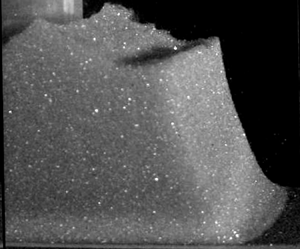Crossref Citations
This article has been cited by the following publications. This list is generated based on data provided by
Crossref.
Hoggarth, Johnathan
Ono-dit-biot, Jean-Christophe
and
Dalnoki-Veress, Kari
2023.
Two-dimensional spreading of frictionless adhesive oil droplets.
Soft Matter,
Vol. 19,
Issue. 20,
p.
3747.
Staron, Lydie
Duchemin, Laurent
and
Lagrée, Pierre-Yves
2023.
Cohesive granular columns collapsing: Numerics questioning failure, cohesion, and friction.
Journal of Rheology,
Vol. 67,
Issue. 5,
p.
1061.
Wu, Yisong
Sun, Yinghao
and
Wang, Dengming
2023.
The combined effect of cohesion and finite size on the collapse of wet granular columns.
Soft Matter,
Vol. 19,
Issue. 48,
p.
9520.
Chatre, Lucas
Lemerle, Xavier
Bataille, Marc
Debacq, Marie
Randriamanantena, Tojonirina
Lamadie, Fabrice
Nos, Jeremy
and
Herbelet, Florian
2024.
Experimental study of the wall particle motion in a screw reactor.
Powder Technology,
Vol. 448,
Issue. ,
p.
120181.
Chatre, Lucas
Lemerle, Xavier
Bataille, Marc
Herbelet, Florian
Debacq, Marie
Nos, Jeremy
Saleh, Khashayar
Leturia, Mikel
and
Randriamanantena, Tojonirina
2024.
Numerical study of dense powder flow in a rotating drum: Comparison of CFD to experimental measurements.
Powder Technology,
Vol. 444,
Issue. ,
p.
119981.
Blatny, L.
Gray, J.M.N.T.
and
Gaume, J.
2024.
A critical stateμ(I)-rheology model for cohesive granular flows.
Journal of Fluid Mechanics,
Vol. 997,
Issue. ,
Karuriya, Ashta Navdeep
Simoes, Jeremy
and
Barthelat, Francois
2024.
Fully dense and cohesive FCC granular crystals.
Extreme Mechanics Letters,
Vol. 71,
Issue. ,
p.
102208.
Rousseau, Hugo
Gaume, Johan
Blatny, Lars
and
Lüthi, Martin P.
2024.
Transition Between Mechanical and Geometric Controls in Glacier Crevassing Processes.
Geophysical Research Letters,
Vol. 51,
Issue. 9,
Gans, Adrien
Dalloz-Dubrujeaud, Blanche
Nicolas, Maxime
and
Aussillous, Pascale
2024.
Discharge Flow of a Cohesive Granular Media from a Silo.
Physical Review Letters,
Vol. 133,
Issue. 23,
Bhat K. I., Manasa
Hurley, Ryan C.
and
Murthy, Tejas G.
2024.
Micromechanics of contact-bound cohesive granular materials in confined compression.
Physical Review E,
Vol. 109,
Issue. 5,
Zhu, Rui
He, Zhiguo
and
Meiburg, Eckart
2024.
Effects of initial packing density and cohesion on submerged granular collapse.
Physical Review Fluids,
Vol. 9,
Issue. 8,
Sharma, Ram Sudhir
Sarlin, Wladimir
Xing, Langqi
Morize, Cyprien
Gondret, Philippe
and
Sauret, Alban
2024.
Effects of interparticle cohesion on the collapse of granular columns.
Physical Review Fluids,
Vol. 9,
Issue. 7,
Zhang, Shuai
Xu, Jiayu
Syed, Abul Hassan
Hua, Leina
Wu, Chuan-Yu
Lian, Guoping
and
Ge, Wei
2025.
Numerical and experimental investigation of the effect of interstitial liquid viscosity on the collapse of wet granular columns.
Chemical Engineering Science,
Vol. 301,
Issue. ,
p.
120725.
Wu, Yisong
Tang, Hu
Zhang, Yuantao
and
Wang, Dengming
2025.
The effect of particle size distribution on the collapse of wet polydisperse granular materials.
Computers and Geotechnics,
Vol. 177,
Issue. ,
p.
106854.




